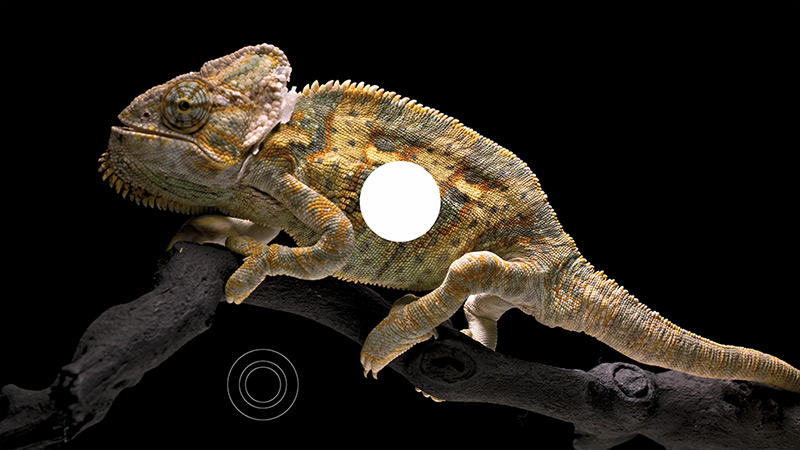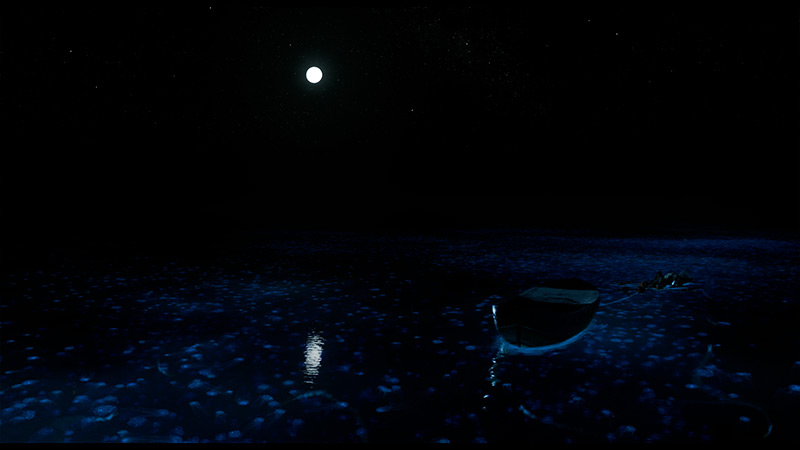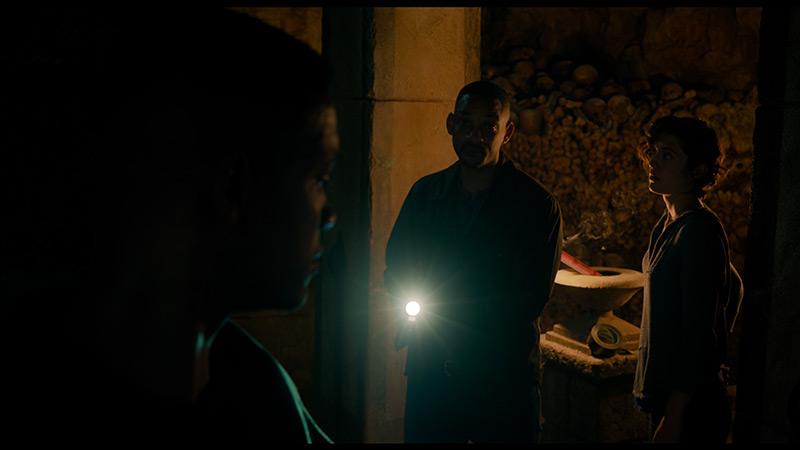Hisense proves here that it can deliver products of really decent quality. The Hisense U7NQ is a television that offers many advantages, with its picture quality being one of its main assets. Thanks to Mini LED technology, this television offers deep blacks and high brightness, positively influencing contrast and image dynamics. Dolby Vision support further increases the capabilities of this model, providing cinematic experiences at home. When it comes to motion smoothness, the Hisense U7NQ is a great choice for gamers and those who appreciate dynamic content, such as sports. The rapid 144 Hz panel, low input lag, and additional features like VRR, ALLM, and Game Bar make gameplay on this television smooth and responsive. For daily usage, the television deserves praise for its high efficiency during the day. The high brightness level of 915 cd/m² means that the television performs well even in bright rooms, and additional features like the ability to record programs make it a very functional everyday choice. Despite all its advantages, the Hisense U7NQ also has its drawbacks. The VIDAA operating system, while fast, is not yet as developed as other platforms available on the market, resulting in the absence of several popular applications such as Spotify or Tidal. Gamers may be disappointed by the lack of support for HGiG, which affects the optimal reproduction of details in HDR games. If we plan to connect the television to a computer, we must reckon with issues related to font readability, especially on dark backgrounds. The Hisense U7NQ is a solid TV that offers very good picture quality and rich features for gamers. Despite a few shortcomings, it is a model that will satisfy most users, providing high picture quality, motion smoothness, and useful user features.
- Matching (Score)
- Our verdict
- TV appearance
- Where to buy
- Contrast and black detail
- HDR effect quality
- Factory color reproduction
- Color reproduction after calibration
- Smoothness of tonal transitions
- Image scaling and smoothness of tonal transitions
- Blur and motion smoothness
- Console compatibility and gaming features
- Input lag
- Compatibility with PC
- Viewing angles
- Daytime performance
- Panel details
- TV features
- Apps
- Playing files from USB
- Sound
Hisense U7NQ vs Sony X75WL
Direct comparison
Check the best price offer:
Hisense U7NQCheck the best price offer:
Sony X75WLU7NQ


Panel type: LCD VA
Resolution: 3840x2160
System: VIDAA
Model year: 2024
Complete the survey to find out the result

Panel type: LCD IPS
Resolution: 3840x2160
System: Google TV
Model year: 2023
Complete the survey to find out the result

Overall rating
7.3
5.9
Movies and series in UHD quality
7.0
5.6
Classic TV, YouTube
6.7
5.3
Sports broadcasts (TV and apps)
6.4
5.5
Gaming on console
8.2
5.7
TV as a computer monitor
8.0
6.0
Watching in bright light
7.6
4.6
Utility functions
9.0
7.7
Apps
7.7
9.6
Sound quality
6.9
6.9
Complete the survey to find out what fits your preferences
Advantages
Good contrast
High brightness of the panel - good performance during the day
Very good for gamers, sports - VRR, ALLM 144Hz
Low input lag
Recording function from built-in tuners
Google TV system with convenient voice control and access to applications
Ability to record to external USB drive and connect peripherals
Good viewing angles thanks to IPS panel
Very good cooperation with PC (chroma 4:4:4, low input lag)
Pleasant, clear sound with gentle bass
Adjustable leg spacing
Disadvantages
Not the best Image scaling and smoothness of tonal transitions
Very weak contrast
Average color palette coverage
Poor for gamers - lacks many features
Design - thick bezels will not appeal to most
Our verdict
The Sony X75WL model, introduced in 2023 and carried into 2024, offers a range of attractive features. Running on the Google TV platform, it provides users with personalised recommendations based on their preferences and previously viewed content. Key applications like Netflix, YouTube, and Amazon Prime Video are readily available, and full integration with the Google Play Store allows for downloading additional apps, including games and media players. The built-in Google Assistant enhances usability, enabling voice-command control for a more seamless user experience.
The TV’s versatility is evident with features such as USB recording and peripheral connectivity, making it practical for various user needs. Its strong compatibility with PCs, supported by chroma 4:4:4 and low input lag, positions the X75WL as a good option for office work or home use. Audio performance is also commendable, offering subtle bass and clear sound that should satisfy most casual listeners without external speakers.
However, the X75WL does come with some limitations. Its low contrast and average HDR performance mean it is not the best choice for dark-room viewing, where deep blacks and detailed image quality are important. Additionally, the thicker bezels may not be aesthetically appealing to some users. Despite these drawbacks, the X75WL is still a versatile and practical television, particularly for those seeking functionality at a reasonable price. For those not committed to the brand, exploring competitive models might be worthwhile, as they may offer a superior quality-to-price ratio.
TV appearance








Contrast and black detail
7.2/10
2.4/10
Local dimming function: Yes, number of zones: 713 (31 x 23)
Local dimming function: No
Contrast:

Result
40,750:1

Result
42,600:1

Result
12,000:1

Result
12,150:1

Result
3,450:1

Result
1,100:1

Result
1,200:1

Result
1,300:1

Result
1,400:1

Result
900:1
Halo effect and black detail visibility:


Hisense U7NQ is a television that uses a VA panel, crucial for achieving good contrast and appropriate black depth. This technology translates into vivid image quality when watching content in a dark room, where blacks acquire proper saturation and resemble deep tar rather than washed-out ash. Moreover, the TV features Mini LED backlighting, which in the tested 65-inch variant offers an impressive number of 713 local dimming zones. Naturally, smaller sizes will have fewer zones, while larger ones will have more, positively affecting overall contrast.
Under very favourable conditions, the TV achieves a contrast ratio of around 40,000:1. The local dimming technology performs excellently at managing bright and dark parts of the image, making the TV superbly render details in complex scenes. Despite the large number of zones, there may be issues with contrast in particularly demanding scenes, where small bright elements appear against a dark background. Sometimes the TV may dim these elements too much, causing a loss of brightness, and other times it excessively brightens them, leading to a halo effect—glows of light surrounding objects. This effect can be noticeable, for example, in a scene from the movie Sicario 2, where bright glows around the subtitles can be bothersome.
Nevertheless, the use of Mini LED technology with local dimming makes the overall image quality significantly better than in televisions without this technology. The effect is particularly noticeable when watching movies in a dark room—the blacks are deeper, and the contrast is more pronounced, allowing a full appreciation of details hidden in dark shots.
The Sony X75WL model is equipped with an IPS panel, which, while offering good viewing angles, unfortunately compromises black levels and contrast. This results in shallow blacks and a lack of detail in dark scenes, diminishing the overall image quality for movie enthusiasts. For instance, in films similar to The Revenant, shadow details are nearly invisible, causing the visuals to appear flat and lacking depth. The limited contrast performance of the IPS panel may not meet the expectations of more discerning viewers, especially those who value rich and detailed picture quality during night-time viewing. Compounding these limitations is the absence of local dimming functionality, which prevents the TV from adequately enhancing black levels or contrast in dimly lit scenes. This drawback further impacts the visual experience, making it less suitable for those prioritising deep blacks and high contrast in their home entertainment setup.
HDR effect quality
5.9/10
5/10
Luminance measurements in HDR:

Result
1023 nit

Result
290 nit

Result
637 nit

Result
198 nit

Result
907 nit

Result
285 nit

Result
308 nit

Result
343 nit

Result
345 nit

Result
358 nit
Scene from the movie “Pan” (about 2800 nits)


Scene from the movie “Billy Lynn” (about 1100 nits)


Static HDR10


Dynamic: Dolby Vision
Dynamic: Dolby Vision


HDR luminance chart:
Sony X75WL
HDR luminance
Hisense U7NQ
HDR luminance
The Hisense U7NQ 65 television demonstrated significant capabilities on the luminance chart, exceeding the 1000-nit barrier and achieving very high brightness results without issue in the first, third, and fifth test scenes. However, as before, in the second and fourth test scenes, for example from the film Sicario 2, there are significant problems with maintaining brightness, and the results around 200 nits are very disappointing. Despite a large number of dimming zones, the algorithm in the television responsible for controlling these zones is unable to react appropriately — in this case, it significantly dims small elements like the moon or the light from a helicopter. The bright light that should blind us is too dim to be called an HDR effect. Nevertheless, it is worth praising the television for its high coverage of the DCI-P3 colour gamut at 96%, which allows it to accurately reproduce most film scenes.
The luminance chart for the Sony X75WL revealed a peak brightness of just 350 nits, which is underwhelming for an HDR-capable display. This limited brightness means that HDR scenes lack the depth and impactful highlights expected for immersive viewing. Additionally, the subpar coverage of the DCI-P3 colour gamut results in a less vibrant colour representation, negatively impacting the overall quality of HDR content. The combination of insufficient brightness and poor colour gamut coverage significantly diminishes the intended HDR effect, making this model a less compelling choice for those prioritising HDR performance.
Factory color reproduction
6.4/10
6.9/10


Factory Mode
After calibration


Factory Mode
After calibration
The Chinese manufacturer offers various picture settings with its televisions, but the best mode in this model is undoubtedly the Filmmaker Mode. Despite its name, this mode has its issues: the white balance, although roughly correct, is characterized by a strong dominance of warm tones due to the kick of red colour, both in 4K and HD materials. The Colour Checker test confirms these errors — deviations in samples are visible in inappropriate shades. As for the brightness characteristics, the gamma responsible for HD materials shows values below 2.4, leading to some brightening of the screen. Meanwhile, the EOTF curve shows the television's problems with displaying small light elements, as confirmed by the previously described paragraphs.
Colour reproduction tests on the X75WL model, conducted in movie mode, reveal strengths and weaknesses. While movie mode offers some of the best image settings, it is not flawless. One of the most significant issues with the X75WL is the white balance, particularly for HD and 4K HDR content, where a blue hue dominates the image. This results in a noticeably cold tone throughout. The colour checker confirms these discrepancies, showing a clear shift towards cooler shades.
Regarding brightness, the contrast gamma level is generally acceptable, but the EOTF curve presents more challenges. There are noticeable problems with maintaining consistent brightness, with the image sometimes appearing too washed out or too dim. These issues affect the overall visual experience and hinder the accurate perception of content.
Color reproduction after calibration
7.8/10
7.1/10




Hisense televisions offer many tools for image correction, allowing users to adjust settings to their preferences. Therefore, we decided to utilize these capabilities to bring the image quality closer to reference standards. In the case of white balance, we managed to eliminate the dominance of red, resulting in more neutral colours, which allowed for a more realistic image in both 4K and HD materials. A similar improvement was noticed in the brightness characteristics. Gamma, which previously led to excessive screen brightness, was corrected, contributing to better detail representation in the darker areas of the image while maintaining a natural tonal balance.
However, the biggest challenge was the calibration of the EOTF curve, which is responsible for brightness in 4K materials. At first glance, the EOTF value appeared almost perfect, but detailed tests showed a slightly different outcome. Upon closer inspection—especially using the filter on the right side of the EOTF chart—we noticed how the television manipulated 4K film materials, often significantly boosting brightness. This effect was particularly noticeable in scenes from films such as Pan and Billy Lynn, where the television attempted to artificially increase the brightness of elements, affecting their naturalness. Despite these imperfections, the calibration yielded positive results, especially in terms of tonal improvement. For most users, the final effect should be satisfactory, especially if they aim to bring image quality closer to professional reference standards.
The X75WL is one of those cases where image calibration may not lead to a dramatic transformation, but it does offer a notable improvement in colour perception. The white balance for HD and 4K content, has been significantly enhanced, eliminating the strong dominance of cooler tones. The gamma chart also appears more stable, resulting in better image quality overall. However, the main issue remains the EOTF curve, which controls brightness in 4K content. Due to the technological limitations of the television (such as the IPS panel and the absence of local dimming), a significant improvement is difficult to achieve, as the model’s capabilities are constrained. Despite these limitations, the tonality of the image has been substantially improved.
Smoothness of tonal transitions
9.1/10
8.1/10












Hisense U7NQ offers excellent fluidity of tonal transitions. Overall, the image is very well balanced, and transitions between different shades of colors are nearly flawless. For more discerning viewers, small joinings in darker hues can be detected; however, these imperfections are minimal and do not significantly affect the overall picture quality. Tonal fluidity is at a very high level, making viewing content on this television particularly enjoyable, with no noticeable problems with gradients and color transitions.
The X75WL model performs well in terms of tonal transition fluidity. Shadow gradation is solid, with no noticeable issues, which enhances image quality in darker scenes. Brighter scenes bring minor fluidity issues but are subtle and unlikely to impact viewing comfort. In a scene with intense red hues, slight clipping can be observed, but it does not significantly detract from the viewing experience.
Image scaling and smoothness of tonal transitions
5.5/10
6.1/10
Smooth transition function


Image without overscan on the SD signal


When it comes to smoothing tonal transitions, despite the presence of the "Smooth and Gradient Image" feature in the test sequence, we did not notice that the feature added anything — we recommend turning it off. As for upscaling, the television handled our model well, and the branches in the background are not excessively jagged — the image seems quite plastic. However, it was slightly cropped by the so-called overscan.
The X75WL struggles with low-quality tonal transitions. The lack of any function to improve tonal gradation results in noticeable imperfections in colour transitions, which detracts from the overall image quality. However, the digital processing is commendable, with the image displayed without overscan, and relatively sharp presentation. This added sharpness may appeal to some users, though it does not compensate for the tonal transition issues.
Blur and motion smoothness
7.3/10
4.9/10


Blur (native resolution, maximum refresh rate):






Blur (BFI function enabled):






Hisense U7NQ has a refresh rate of 144 Hz, which definitely contributes to smooth motion. For movie enthusiasts, there are two features available: judder reduction and motion blur reduction. The judder reduction feature minimizes the effect of so-called judder, which is the unpleasant stuttering of the image, particularly noticeable at lower frame rates. On the other hand, motion blur reduction helps sharpen fast-moving objects, which is useful when watching dynamic action scenes.
As for motion blur, the TV has a decent response time, so excessive blurriness is not visible, except in specific situations, such as the test with the little green alien on a dark background. In such cases, slight artifacts may appear, but overall, the TV handles dynamic images well, providing satisfactory motion quality.
The X75WL features a 60 Hz panel, making it more suited for movie-watching than high-speed gaming. It is equipped with a motion smoother function called Motionflow, which allows users to adjust picture fluidity on a 10-point scale. This function adds intermediate frames, improving motion smoothness and creating a more cinematic effect by reducing choppiness. Additionally, the clarity adjustment helps reduce motion blur, making it particularly beneficial for fast-paced scenes like sports or dynamic action sequences in films. With these settings, users can fine-tune the fluidity and sharpness of motion to their preferences.
Console compatibility and gaming features
8.5/10
3.6/10
- ALLM
- VRR
- VRR range48 - 144Hz
- Dolby Vision Game Mode
Yes, high input lag
- Correct implementation of HGIG
- 1080p@120Hz
- 1440p@120Hz
- 4K@120Hz
- Game bar








Hisense U7NQ offers everything a gamer might need for comfortable gameplay. The TV supports a refresh rate of 144 Hz, providing an incredibly smooth image, especially in dynamic action games. The VRR (Variable Refresh Rate) feature ensures that the image adapts to changing frames per second, eliminating stuttering and tearing. Additionally, there is an ALLM (Auto Low Latency Mode) feature that automatically switches the TV to game mode, minimizing input lag.
The TV also supports Dolby Vision, which is particularly important for gamers who value high contrast and vivid colors in games that support this format. The Hisense U7NQ also has a Game Bar feature that allows quick access to essential settings during gameplay, as well as support for G-Sync technology, which further reduces image tearing.
Unfortunately, despite the wide range of features, support for the most popular HDR format in gaming — HGiG — is lacking. This may be disappointing for gamers who expect optimal detail representation in HDR scenes. Nevertheless, the remaining features make the Hisense U7NQ a solid choice for any console gaming enthusiast.
The X75WL is not the best television for gamers, as it lacks some key features that more demanding users expect. While it includes the Auto Low Latency Mode (ALLM) and a basic Game Bar, these are not sufficient for a truly immersive gaming experience. In this price range, features like VRR (Variable Refresh Rate) and a 120 Hz refresh rate—at least in Full HD—have become standard, but unfortunately, these are missing in the X75WL. This is a significant drawback for Sony, as the competition offers more advanced gaming features at a similar price.
Input lag
9.8/10
8.5/10
SDR
HDR
Dolby Vision
Input lag on the Hisense U7NQ is at a remarkable level, with a maximum of 16 ms, which is an excellent result even in Dolby Vision mode. This achievement is worth highlighting, as Dolby Vision mode often increases delays in other TV models, but here it has been avoided. Thanks to the low input lag, gameplay is smooth and responsive, which will be appreciated by both casual gamers and more advanced users.
The X75WL offers a very low input lag of 14 ms, which is a major advantage for gamers requiring quick TV response to controller commands. However, the input lag increases drastically to 130 ms when using Dolby Vision mode, which makes it unsuitable for gaming. This significant latency in Dolby Vision mode negatively impacts comfort and precision during gameplay, meaning users who prefer this format will experience considerable delay, which is detrimental to their gaming performance.
Compatibility with PC
8/10
6/10


Hisense U7NQ offers full support for chroma 4:4:4, which ensures good font readability, especially when working with text. Overall, the image quality and visibility of characters are at a satisfactory level. However, it is worth noting the issue related to displaying fonts on a dark background — in this situation, the letters become practically invisible, and only vertical subpixels are visible.
The X75WL model performs well as a computer monitor. 4:4:4 chroma support ensures excellent font readability, making text-based work comfortable and clear. The low input lag further enhances the experience, providing smooth and responsive operation. This combination makes the X75WL a convenient and enjoyable option for users looking to use the TV as a computer display.
Viewing angles
3.1/10
6.8/10
The viewing angles on the Hisense U7NQ are typical for a VA panel. Unfortunately, they leave much to be desired. The television lacks a coating that widens the viewing angles, resulting in a significant drop in image quality when viewed at an angle. Colors become washed out, and contrast noticeably decreases, making this television best suited for viewing directly head-on. This is a limitation that needs to be considered, especially if we intend to watch television in a larger group, where viewers may be sitting at different angles.
The viewing angles on the X75WL model are quite good, thanks to the IPS panel. The image remains relatively accurate, even when viewed from an angle, which is beneficial in rooms where the TV is watched from multiple locations. However, better models with IPS panels offer more consistent colour and contrast quality at wider angles.
Daytime performance
7.6/10
4.6/10




Panel brightness
Average luminance SDR
Sony X75WL: 334 cd/m2
Hisense U7NQ: 915 cd/m2
Hisense U7NQ is equipped with a matte coating panel that moderately suppresses reflections. Nevertheless, a brightness level of 915 cd/m² is impressive and ensures that the television performs very well even in bright rooms. With such high brightness, watching content during the day is not a problem, and the image remains clear and legible even with a large amount of external light.
The X75WL's performance during the day is average. The satin coating of the panel moderately reduces reflections, meaning that in bright rooms, reflections may still be visible and affect image clarity. Additionally, with a brightness level of 330 cd/m², the TV struggles to deliver a clear image in very sunny environments, limiting its usability in well-lit rooms.
Panel details
Subpixel Structure:


Panel uniformity and thermal imaging:


Hisense U7NQ
Sony X75WL
TV features
9/10
7.7/10
- HDMI inputs2 x HDMI 2.0, 2 x HDMI 2.1 48Gbps4 x HDMI 2.0, 0 x HDMI 2.1
- Other inputsRCA (Chinch)
- OutputsToslink (Optical audio), eARC (HDMI), ARC (HDMI), Mini-Jack (Headphones)Toslink (Optical audio), eARC (HDMI), ARC (HDMI)
- Network InterfacesWi-Fi 2.4GHz, Wi-Fi 5GHzWi-Fi 2.4GHz, Wi-Fi 5GHz, Ethernet (LAN) 100Mbps
- TV receptionDVB-T, DVB-T2, DVB-S, DVB-S2, DVB-CDVB-T, DVB-T2, DVB-S, DVB-S2, DVB-C
Classic features:
- Recording to USB (terrestrial TV)
- Recording programming
- Picture in Picture (PiP)
- RF remote control (no need to aim at the screen)
- Backlit remote control
- Teletext
- Audio only mode
- Bluetooth headphones support
- Simultaneous Bluetooth headphones & TV audio
Smart features:
- AirPlay
- Screen mirroring (Windows Miracast)
- Voice search
- Voice search in native language
- Ability to connect a keyboard and mouse





Hisense U7NQ uses the VIDAA operating system, which generally works quickly and smoothly, offering a user-friendly interface. There are plenty of applications available, but unfortunately, it lacks music apps like Spotify or Tidal. This is a limitation that may discourage users looking for a more developed app ecosystem.
The TV offers many useful user features that enhance its versatility. The ability to record programs, support for AirPlay, and Bluetooth for connecting various peripheral devices mean that the Hisense U7NQ can successfully serve as a central point for home entertainment.
Hisense U7NQ looks modern thanks to its narrow bezels and elegant single stand that pairs well with the rest of the device. However, the device itself is not among the sleekest on the market, especially compared to competing models from Korean manufacturers known for their exceptionally thin TVs. Despite this, Hisense U7NQ still offers an aesthetic and stylish design that will easily fit into most interiors.
The X75WL model operates on the Google TV system, an enhanced version of Android TV, providing a wide range of features that enhance the user experience. Google TV offers personalized recommendations based on user preferences and viewing history, making it easier to discover interesting content. It also provides seamless access to popular streaming apps such as Netflix, YouTube, and Amazon Prime Video, as well as full integration with the Google Play Store, allowing users to download additional apps and games. Built-in Google Assistant permits the TV to be controlled using voice commands, adding convenience.
The TV also offers a variety of practical features for everyday use. The ability to record programmes onto an external USB drive makes saving and revisiting content easy, particularly useful for live broadcasts. Additionally, the X75WL supports various peripheral devices, such as keyboards, mice, and Bluetooth headphones, further increasing its versatility. The included remote control operates via radio, meaning you don't need to aim it at the screen, making everyday adjustments like changing channels or the volume more convenient.
In terms of design, the X75WL offers a solid, if not the slimmest, appearance. The bezels around the screen are reasonably sized but not the thinnest available. However, the overall aesthetic is pleasing. The TV comes with sturdy, adjustable metal legs, allowing users to set them at different widths to suit narrow furniture spaces, adding flexibility and ease of placement.
Playing files from USB
9/10
8.7/10
Supported photo formats:
Maximum photo resolution:


The built-in media player in the X75WL model performs quite well, supporting most popular video, audio, and image formats without issues. However, if users encounter problems with less common file types, they can easily overcome this by installing an alternative media player from the Google Play Store. This provides a more comprehensive solution, allowing users to fully utilise the TV's capabilities and access a wider range of content formats.
Apps
7.7/10
9.6/10














































Sound
6.9/10
6.9/10
- Maximum volume85dB-
- Dolby Digital Plus 7.1
- Dolby True HD 7.1
- Dolby Atmos in Dolby Digital Plus (JOC)
- Dolby Atmos in Dolby True HD
- DTS:X in DTS-HD MA
- DTS-HD Master Audio
The sound on the X75WL model is surprisingly pleasant, especially for a TV of this class and size. The bass is subtle yet noticeable, and the overall sound quality is clear, enhancing the multimedia experience. The television effectively handles both dialogue and sound effects, making it suitable for a variety of content, from movies to sports, providing a satisfying audio experience without the need for additional sound equipment.
